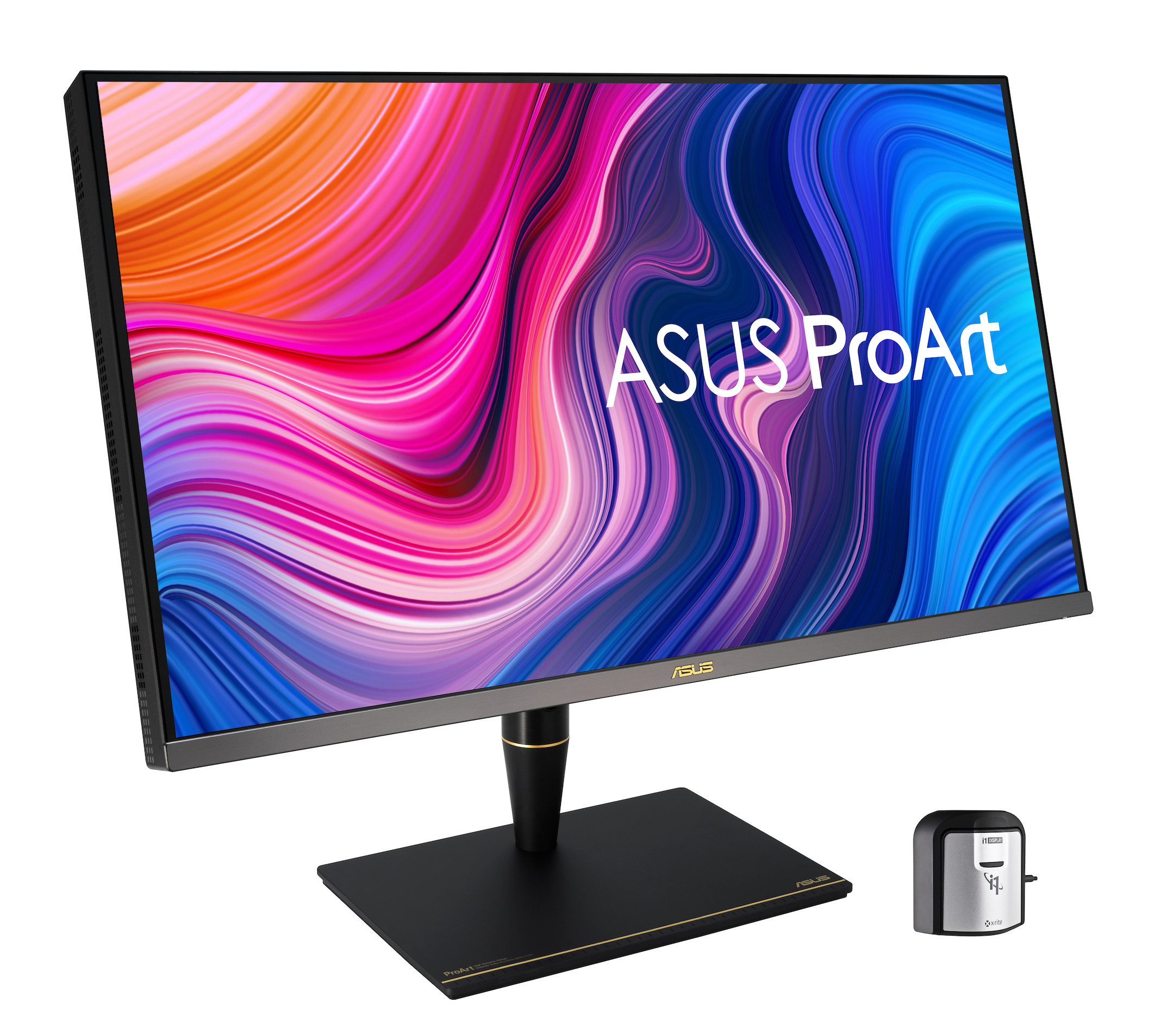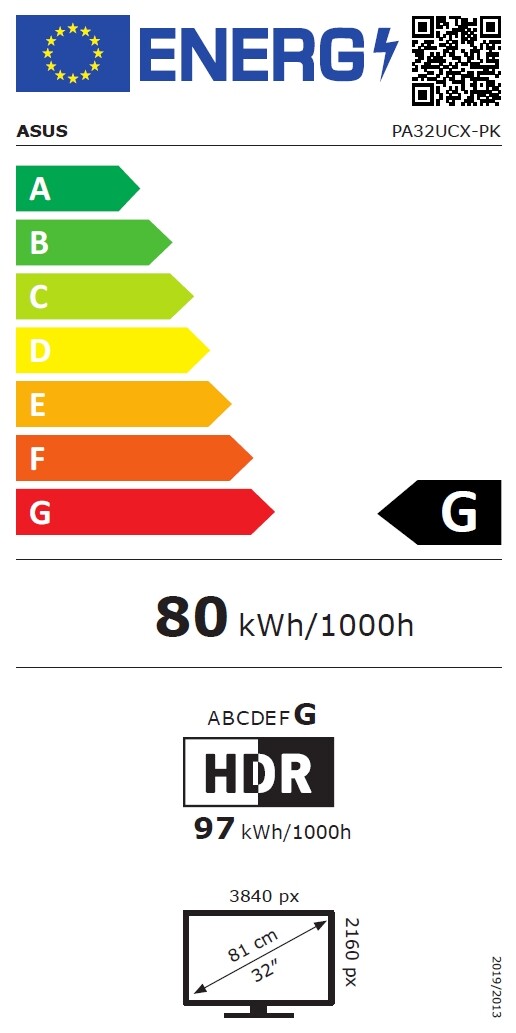



















- Resolution 3840 x 2160 4K UHD
- Diagonal 32"
- Panel type IPS
- Refresh Rate 60Hz



Product information
- 4K HDR IPS MiniLED Professional Monitor - 81.28cm (32 inch), 1200cd/m², Off-Axis ContrastOptimisation, 10 Bit, Dolby Vision, HLG, 1,152 Zones, Delta E 81.28cm (32 inch)4K HDR display for creative professionals
- 81.28cm (32 inch)4K HDR display for creative professionals, which features mini LED backlightingwith 1,152 zones and reaches a maximum brightness of 1,200cd/m²
- TheASUS Off-Axis Contrast Optimisation technology reduces halo effects by 80% and offers aand provides a 7-fold improvement in contrast ratio for dark areas of the picture,when viewing the screen from an angle
- True10-bit colours with Quantum Dot technology deliver colour gamut coverage of89% Rec. 2020, 99.5% Adobe RGB, 99% DCI-P3 and 100% sRGB for anexceptional colour fidelity
- The support for varioushDR formats (Dolby Vision, HDR-10, HLG) enables a true-to-naturelifelike presentation and ensures maximum flexibility
- World-wide leadingleading Delta-E (Delta E)
- Thunderbolt 3USB-C enables data transfer rates of up to 40Gbps and delivers up to60W power to external devices
Master collaborative HDR workflows
The ASUS ProArtPA32UCX-PK is an 81.28cm (32-inch) 4K HDR monitor designed for demandingContent creators such as filmmakers, cinematographers and colouristsand colourists. When multiple content creators work together on the same screen,it is essential that they all see the same colours and the sameContrast range. With the new Off-Axis Contrast Optimisation technology(OCO), which reduces halo effects when viewing the monitor from a wide angle, the ProArtAngle, the ProArt PA32UCX-PK ensures that the content on theContent is faithfully reproduced for all viewers. TheProArt PA32UCX-PK features a maximum brightness of 1,200cd/m² and aMini-LED backlighting, with local1.152-zone brightness control and support for multiple HDR formats,including Dolby Vision, HLG and HDR-10, with true 10-bit colour andQuantum Dot technology, support for DCI-P3, Rec. 709, Rec. 2020 andAdobe RGB colour spaces, as well as a wide range of connectivity options,the ProArt PA32UCX-PK delivers exceptional picture quality that sets new standardsStandards.
Excellent colour and contrast from every angleViewing angle
LED displays with direct backlighting aredirect backlighting are characterised by narrow viewing anglesof the screen. This can make it difficult to collaborate with customers or colleagues on colour-critical workColour-critical work, as inaccurate colours are displayed to viewers sitting to the side.
TheASUS Off-Axis Contrast Optimization (OCO) technology solves this problem by adding aa compensation layer that controls the light transmission at the edgesedges. This reduces halo effects by 80% and provides a 7-foldImprovement in contrast ratio for dark parts of the image,when the monitor is viewed from an angle.
81.28cm (32-inch) 4K monitor withMini LED backlight
The ASUS ProArtPA32UCX-PK 4K monitor is equipped with the technologically leadingMini-LED backlighting, which uses LEDs half the size of conventional screensHalf the size of conventional screens. The smaller sizeallows for a denser array and therefore finer brightness control.The ProArt PA32UCX-PK offers individual backlight control with an impressiveBacklight control with an impressive 1,152 zones. This results in higher luminanceLuminance and deeper blacks, for optimal contrast and the preciseReproduction of HDR content.
ASUS Smart HDR Technology
The ASUS ProArtPA32UCX-PK is equipped with ASUS Smart HDR technology, which supports multipleHDR (High-Dynamic-Range) formats and multiple PQ curves to meet the specialto meet the specific needs of content creation. DolbyVision HDR transforms your viewing experience with an extremely vividDisplay - incredible brightness, contrast and colour to enhance theStorytelling possibilities of content creators. This incredible pictureincredible picture quality is achieved through cinema-inspired HDR technology, which can displaywhich can display billions of colours. Support forHDR-10 ensures compatibility with existing streaming video services and a growing list ofa growing list of HDR-enabled games. The modes PQ Hard Clip Curve, PQOptimised and PQ Basic modes are designed to meet the requirements of content creationContent. The Hybrid Log Gamma (HLG) preset of the PA32UCX-PKallows the user to be immersed in the programme as well as to createMaterial for cable and satellite TV platforms such as BBC iPlayer, JapanNHK TV and DirecTV.
Multiple PQ curves with quick preview
The ASUS ProArtPA32UCX-PK supports multiple HDR-10 (high dynamic range) curves, including PQHard Clip, PQ Optimised and PQ Basic, covering all the needs of content creators
In addition, an HDR preview is availablehDR preview is available - a feature that enables video artists toto connect their camera directly to the ProArt PA32UCX-PK and share recordedHDR content with its full tonal range.
The HDR preview can also be automaticallycan also be used automatically in video editing programs to present ansimulation of the results and thus simplify the editing process
PQ Hard Clip
Maintains accuracy and ensures precise panningAccuracy and provides a precise PQ curve up to the representation of themaximum brightness. Any brightness higher than the maximum of theScreen is limited to the screen maximum.
PQ Optimized
Represents preciseColour gradations based on the maximum brightness of the monitororientated. Delivers HDR performance optimised for the monitor in questionHDR performance.
PQ Basic
Provides overall HDR performanceoverall HDR performance.
Dolby Vision
Dolby Vision HDRtransforms entertainment experiences into vivid picture quality while deliveringincredible brightness, contrast, colour and detail to bring entertainment to lifeEntertainment to life. With Dolby Vision, the PA32UCX-PK gives contentContent creators that their images will be displayed with the highest consistency
An extremely flexible hardware calibration
Whether you are using aa desktop PC, a notebook or a Mac - with the ASUS ProArt-Hardware Calibration, you can improve the colour accuracy and theHomogeneity compensation
quite easilyadjust. Calibrating the brightness and colour consistency of your monitor is child's play
Technical data
| Name | Asus PA32UCX-PK ProArt 32" IPS Monitor, 3840 x 2160 4K UHD, 60Hz, 5ms |
|---|---|
| Article number | 1000013781 |
| GTIN/EAN | 4718017693585 |
| Manufacturer SKU | 90LM03HC-B01370 |
| EPREL ID | 429620 |
| Model name | PA32UCX-PK ProArt |
| Brand | Asus |
| Product Type | Monitor |
| Product Series | Asus PA Series |
| Technology | LCD |
| Panel type | IPS |
| Resolution | 3840 x 2160 4K UHD |
| Diagonal | 32" |
| Aspect Ratio | 16:9 |
| Viewing angle - Horizontal | 178° |
| Viewing angle - Vertical | 178° |
| Contrast Ratio | 1,000 :1 |
| Max. Brightness | 600 cd/m² |
| Response time | 5ms |
| Refresh Rate | 60Hz |
| Support - VESA | 100 x 100 |
| Inputs | 1x 3,5mm Jack , 1x Displayport , 2x USB-C , 3x HDMI , 3x USB-A |
| Features | AMD FreeSync , Integrated speaker , Rotation , tiltable |
| Product width | 72.7 cm |
| Product height | 47 cm |
| Product depth | 24 cm |
| Weight | 9.7 kg |
| Colour | Black |
| EEK Spectrum | A to G |
| Energy efficency class | G |
| Delivery contents | Power cable , stand |
| Condition | New |
| Warranty | 24 Month |
| Warranty type | Bringin service Service and support information |
Downloads
Product safety
| Person responsible for the EU |
|---|
| Ninepoint GmbH |
| Im Mediapark 8 |
| 50670 Köln |
| Germany |
| info@asus-shop.de |



